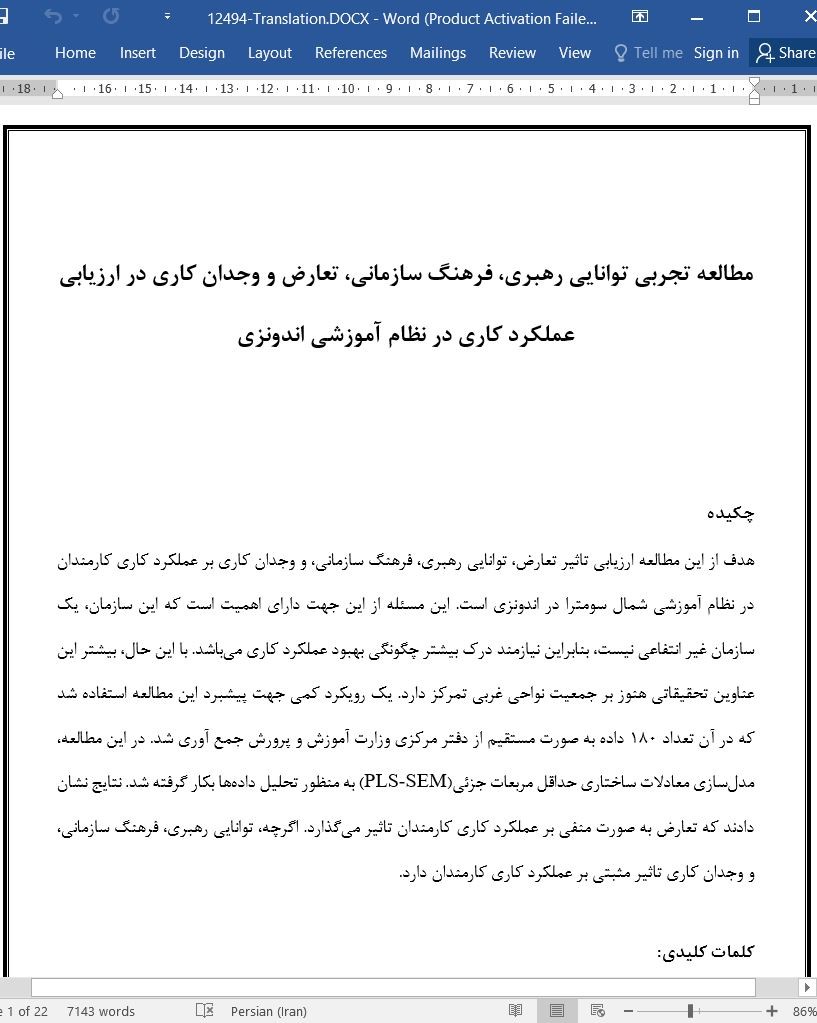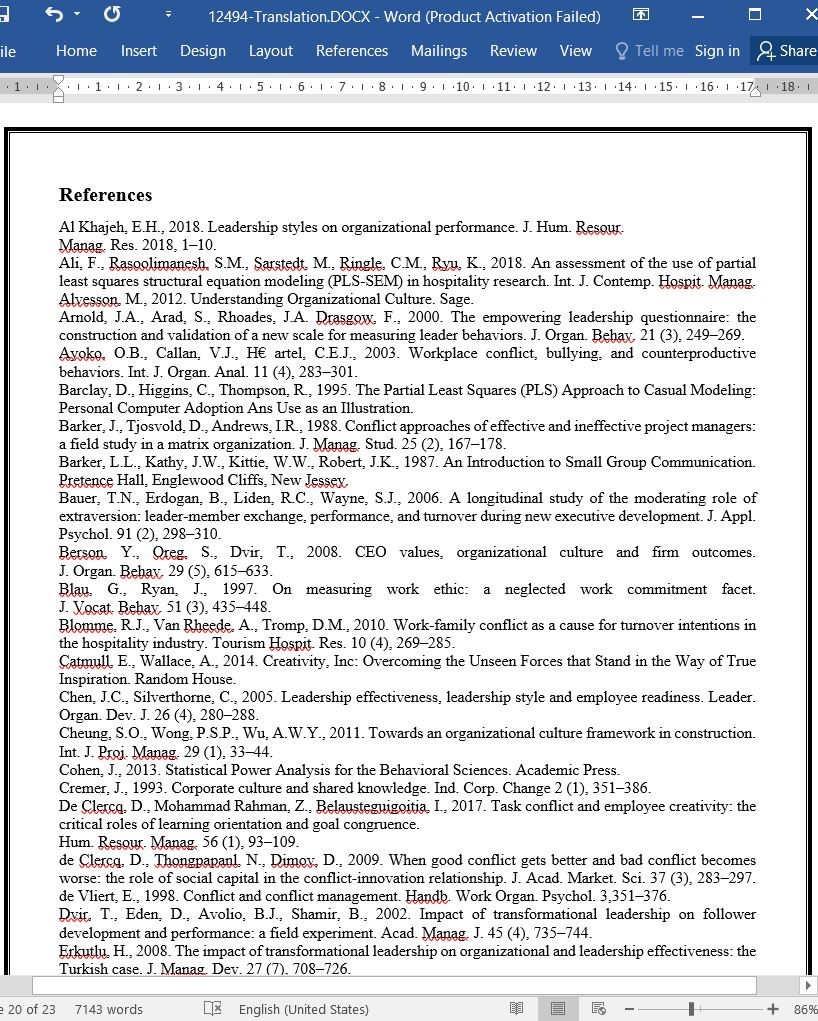
مطالعه تجربی توانایی رهبری، فرهنگ سازمانی، تعارض و وجدان کاری در ارزیابی عملکرد کاری
چکیده
هدف از این مطالعه ارزیابی تاثیر تعارض، توانایی رهبری، فرهنگ سازمانی، و وجدان کاری بر عملکرد کاری کارمندان در نظام آموزشی شمال سومترا در اندونزی است. این مسئله از این جهت دارای اهمیت است که این سازمان، یک سازمان غیر انتفاعی نیست، بنابراین نیازمند درک بیشتر چگونگی بهبود عملکرد کاری می باشد. با این حال، بیشتر این عناوین تحقیقاتی هنوز بر جمعیت نواحی غربی تمرکز دارد. یک رویکرد کمی جهت پیشبرد این مطالعه استفاده شد که در آن تعداد 180 داده به صورت مستقیم از دفتر مرکزی وزارت آموزش و پرورش جمع آوری شد. در این مطالعه، مدلسازی معادلات ساختاری حداقل مربعات جزئی(PLS-SEM) به منظور تحلیل داده ها بکار گرفته شد. نتایج نشان دادند که تعارض به صورت منفی بر عملکرد کاری کارمندان تاثیر می گذارد. اگرچه، توانایی رهبری، فرهنگ سازمانی، و وجدان کاری تاثیر مثبتی بر عملکرد کاری کارمندان دارد.
1. مقدمه
در فضای کاری امروزه، تلاش برای بهبود عملکرد کاری کارمندان، اولین هدف بخش منابع انسانی(HR) است. منابع انسانی نیازمند مدیریت حرفه ای به منظور ایجاد هماهنگی میان منافع کارمندان و منافع سازمان در جهت پیشرفت سازمان است(Mappamiring et al., 2020). علاوه بر این، این موضوع نیازمند ایفای نقش یک رهبر است، زیرا که نقش رهبر در یک سازمان بسیار برجسته است(Bauer et al., 2006; Hall et al., 2001; Salisbury, 1984; Schein, 1983) ، همچنین ذات رهبری در یک سازمان، تاثیرگذاری و هدفمند کردن تلاش های فردی و گروهی اعضا و تلاش جهت پیشبرد اهداف است (Yukl, 2012). توانایی رهبری به عنوان فاکتور ضروری جهت ارزیابی عملکرد کاری کم و زیاد کارمندان در یک سازمان، شناخته می شود(AlKhajeh, 2018; Berson et al., 2008; McColl-Kennedy and Anderson, 2002;Raja et al., 2020; Sonmez Cakir and Adiguzel, 2020). اگرچه، فاکتور توانایی رهبری به تنهایی برای به حداکثر رساندن عملکرد کارمندان کافی نیست. چندین متغیر پیش بینی کننده مانند، فرهنگ سازمانی، تعارض، وجدان و عملکرد کاری نیز بر روی عملکرد کارمندان تاثیرگذار هستند(Barker et al., 1987; Graham et al., 2017; Lau and Cobb, 2010; Lee et al., 2011; McColl-Kennedy and Anderson, 2002; O'Reilly, 1989; Schaubroeck et al., 2011; Wang et al., 2014).
Abstract
This study aimed to examine the influence of conflict, leadership, organizational culture, and work ethic on employees' work performance in North Sumatra Education Authority, Indonesia. This becomes important because this organization is not a profit-oriented organization, so it needs further understanding about how to foster the work performance. However, most of these research topics still concentrate on the western populations. A quantitative approach was used to conduct this study, where data were collected directly to the office of Education Authority with n = 180. Partial Least Square Structural Equation Modeling (PLS-SEM) is employed for data analysis in this study. The results showed that conflict negatively affects employees' work performance. However, leadership, organizational culture, and work ethic have positive effect on employees' work performance.
1. Introduction
In today's work environment, efforts to improve employee performance are almost the primary goal of human resources (HR). HR needs to be managed professionally to create harmony between the interests of employees and the interests of the organization in an effort to advance the organization (Mappamiring et al., 2020). Moreover, this is the role of a leader, because a leader's role in an organization is very dominant (Bauer et al., 2006; Hall et al., 2001; Salisbury, 1984; Schein, 1983), also the essence of leadership in an organization is to influence and facilitate individual and collective efforts to accomplish their objectives (Yukl, 2012). Leadership is known as an essential factor that determines the high and low of employee work performance in an organization (Al Khajeh, 2018; Berson et al., 2008; McColl-Kennedy and Anderson, 2002; Raja et al., 2020; Sonmez Cakir and Adiguzel, 2020). However, the leadership factor alone is known to be insufficient in maximizing employee performance. Several predictor variables are also suspected to affect work performance, namely organizational culture, conflict, work ethics, and work performance (Barker et al., 1987; Graham et al., 2017; Lau and Cobb, 2010; Lee et al., 2011; McColl-Kennedy and Anderson, 2002; O'Reilly, 1989; Schaubroeck et al., 2011; Wang et al., 2014).
چکیده
1. مقدمه
2. مواد و روش ها
2.1 اندازه گیری ها
2.2 افراد و اندازه نمونه
2.3 جمع آوری داده ها
2.4 آنالیز و تحلیل داده ها
3. نتایج
3.1 ارزیابی مدل های اندازه گیری
3.2 ارزیابی مدل ساختاری
4. بحث
5. نتیجه گیری
منابع
ABSTRACT
1. Introduction
2. Materials and methods
2.1. Measurements
2.2. Population and sample size
2.3. Data collection
2.4. Data analysis
3. Results
3.1. Evaluation of measurement models
3.2. Evaluation of structural model
4. Discussion
5. Conclusion
References
- اصل مقاله انگلیسی با فرمت ورد (word) با قابلیت ویرایش
- ترجمه فارسی مقاله با فرمت ورد (word) با قابلیت ویرایش، بدون آرم سایت ای ترجمه
- ترجمه فارسی مقاله با فرمت pdf، بدون آرم سایت ای ترجمه



